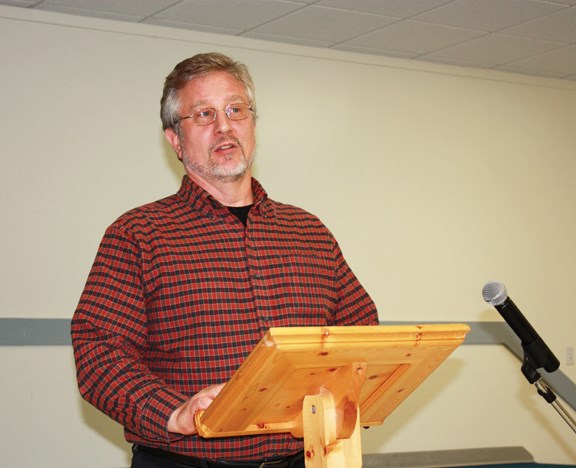Today, cattle producers are thrilled to receive a “$1.30 per pound for their cattle, equivalent to the price in 1987, but how can you be thrilled about that when it should be $2.25?” questioned Cameron Pallet, lead lawyer on a class action law suit against the federal government over the handling of the (bovine spongiform encephalopathy) BSE crisis.
“What would your world be like without the BSE crisis?” said Pallet to an audience of about 20 cattle farmers at a meeting held Thursday night at Flat Lake Hall. “You are entitled under the law to be put in the position that you would have been but for the neglect.”
The lawsuit began in 2005 and alleges that the Department of Agriculture and Agri-Food Canada was negligent in the manner it dealt with the BSE outbreak and that negligence subsequently had a severe economic impact on the livelihood of cattle producers in Canada. He said that this crisis literally cost some producers their lives. “There are about three dozen people that took their own lives as the only way to save the farm for their sons, daughters and mothers (for) the insurance money to pay the mortgage,” said Pallet. “You know what your community went through and what your families went through and it's not funny.”
The lawsuit requests a settlement from the government on behalf of anyone who was a cattle producer as of January, 2003.
At the beginning of his presentation, Pallet provided a brief history of the BSE crisis. In 1985, 1,986 cattle died in Britain and nobody understood why. In 1998, John Wilesmith, a veterinary epidemiologist at the Central Veterinary Laboratory in England, was the first to explain that the disease is spread by feeding cattle and calves the rendered remains of infected ruminants and that the disease had about a five year incubation period. In July of 1988, the UK brought in its first feed ban, which banned the feeding of rendered remains of ruminants. Many countries, such as the U.S., Israel and Australia, banned the import of cattle from England in 1989.
Pallet said that in 1990, the Canadian government brought in new feed regulations with a list of permissible feed ingredients, five of which were types of ruminant meat and bone meal. “I have no idea why they would do that,” he said.
In April of 1990, the government catalogued all 196 cattle that had been imported from the UK and put them in a monitoring program that was supposed to prevent the spread of the disease into the Canadian herd.
“All they had to do was to make sure the cows didn't die, get rendered and turned into calf starter,” said Pallet. But the government didn't put any teeth into the program and didn't educate the cattle owners and tell them that, if the cow dies, it must not be rendered because that would spread the disease.
In a similar monitoring program in Australia, the government contacted farmers that had purchased UK cattle and offered to buy it from them. And if the farmer sold the animal to someone other than the Australian government and it was rendered into animal feed, he/she risked going to jail, he said.
“Do you know how many of those 130 UK animals that made it into the feed system in Australia? Zero. How many of the 196 animals that were identified as being imported from the UK into Canada made it into the feed system? 80,” said Pallet.
The cow that closed the border between the U.S. and Canada on May 20, 2003 was born in Baldwinton, Sask. in 1997. The ruminant meat and bone meal was rendered in Edmonton in February, 1997, and was sold and fed to calf in May of 1997, he said.
“They had three years since they knew they screwed up … to do what they had to do, which was bring in a ruminant feed ban. They didn't even bring in a requirement that calf starter be labeled that it contained ruminant feed and bone meal,” said Pallet. “That would have cost them nothing.
“The level of incompetence and buffoonery is astounding,” said Pallet later in the presentation.
He said he has the evidence and the documentation but it can take up to 10 years to get a class action lawsuit into court. He is hoping that the government will negotiate a settlement. There was a petition circulated at the meeting, requesting that the government settle out of court.
“They did the right thing with the Indian Residential Schools … they sat down and worked out a settlement. If they did the same thing with us, it could be over in 18 months,” Pallet said. “If they would even look at the evidence, that would be nice.”
During the question period, area producer Brian Chomlak pointed out that it could be very important for farmers to keep their records, including income tax information, as they may need those documents later to prove they were a farmer at the time.
In the end, Pallet said producers should contact their MP every day and ask the MP to read the documentation and information that is available on the website.
When contacted, a spokesperson from media relations for the Canadian Food Inspection Agency stated in an email, “The Government of Canada continues to prepare its defense. It would be inappropriate to comment further on this matter at this time, as the matter remains before the court.” She directed anyone with questions on the legal proceedings to contact Department of Justice Canada.



